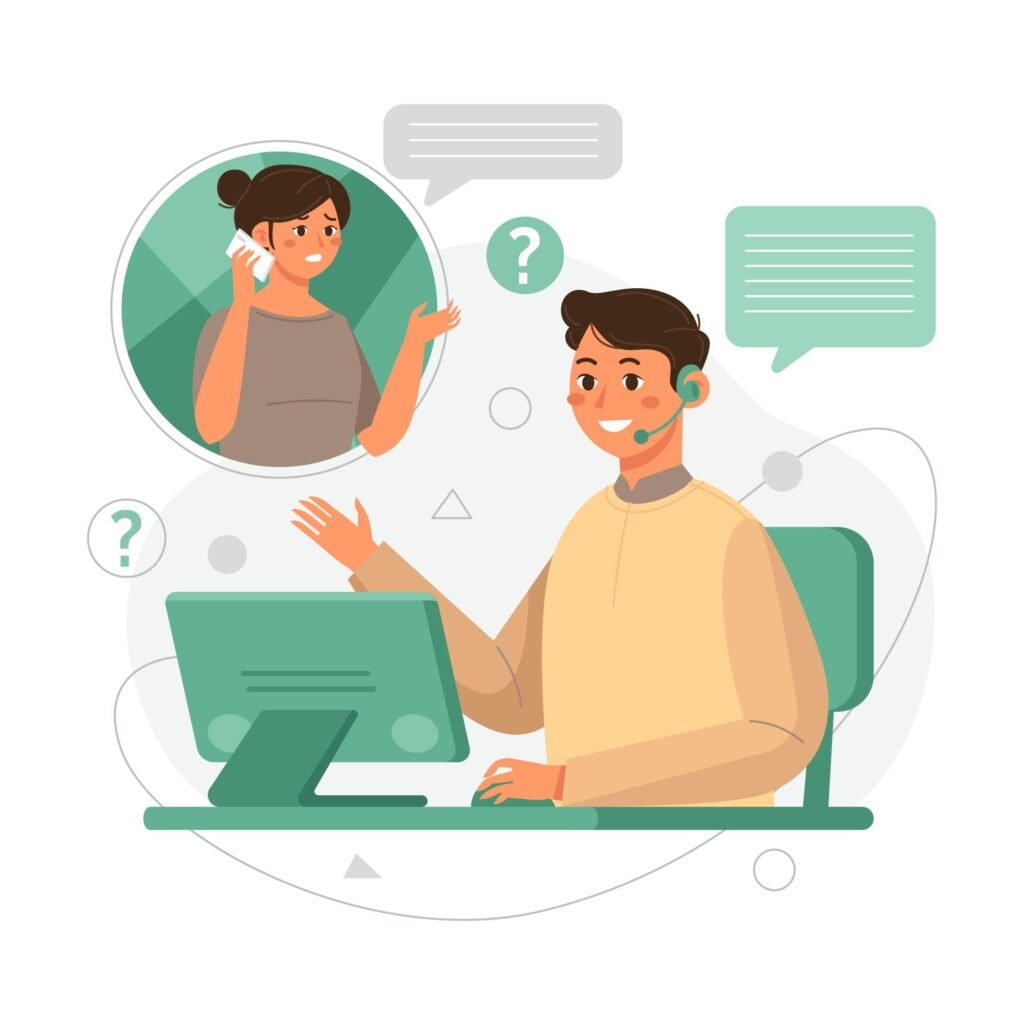
Find the Customer Service Number that you are looking for in the UK by searching below:
Customer Service Number is a telephone directory service which lists hard to find customer service numbers online.
Customer Service Number
We’ve all been in the situation of needing to contact a company to get advice on their products, report a problem, or discuss a bill. Most organisations have expanded the range of options for getting in touch and might allow you to use online chat, WhatsApp, a web contact form or email. However, for many of us, speaking to a customer service advisor is by far the best option. But why are customer service numbers so hard to find? And what can you do to get in touch when companies are trying to make it awkward?

Hidden Customer Service Numbers
Many organisations seem to make it as difficult as possible to contact them by phone. This is usually down to cost. They find it’s cheaper to process enquiries made by email or through virtual chat than it is to employ people to speak to customers on the phone. Phone numbers may be available but are hidden on the website, or not advertised publicly. That’s where our easy to use service comes in. We are here to provide you with all of those numbers which you might want to use to speak to someone at the large companies we all deal with on a daily basis.
All you need to know is the name of the company which you want to contact, not their geographic location or anything else about them. Our customer service number directory is very straightforward and is packed with all the numbers you need to contact high street brands and the companies we all deal with, day in and day out. Once you have found the brand you want to contact, all you need to do is pick up the phone and give them a call. Remember though that most customer services keep business hours, typically Monday to Friday 9am to 5pm, although some larger organisations have customer service lines which are open into the evening, and on weekends too.
How Can Customer Service Help Me?
Customer service is about the support which businesses of all sizes offer to their customers. This could be on just one occasion, or on an ongoing basis. For example, you might want to find out if a particular product you wish to buy is in stock in your local branch. That sort of query is usually dealt with quickly, and once the call has been completed you might never need to contact the company again. On the other hand, there are some companies such as a bank or utility provider, which we have an ongoing relationship with, and might need to speak to several times over the course of a year, or the duration of our contract with them. Companies need to have a well-trained and professional customer service team to deal with everything from the simplest query about store opening hours or delivery through to much more complex problems with a miscalculated bill or fault with an expensive piece of equipment. Most people think that customer service is all about complaining but there is so much more to the service than that.

Organisations know how important it is to get customer service right. A dissatisfied customer will take their business elsewhere, and will often tell lots of their friends and family about their poor experience too. A customer services agent is the “front line” of any organisation, and it is their job to keep customers happy, solve their problems, and retain their business for their employer. Figures show that it doesn’t take much for a customer to turn their back on an organisation which they feel have provided poor service. At a time where times are tough for businesses of all sizes, any good business is doing all they can to keep their customers happy and saying positive things about them rather than negative.
All large companies will have supervisors and team leaders in their customer services department who often have more leeway to agree to refunds or to waive charges which operators cannot. Customers will always get the most out of a customer service call by remaining polite and civil, however tempting it might be to lose your temper and start shouting. Give the first person who answers the phone the chance to resolve your issue first, and only if you feel you are getting nowhere, ask – politely – to be put through to someone more senior. If there is nobody available, then it might be possible to send a letter or email to the chief executive or similar. Social media can also be effective when you are trying to get a company to respond to you. The same rules apply though. Keep it polite and lay out the problem as simply as you can. Also tell the company what you would like them to do to resolve whatever problem you are describing.

Call Costs
One of the other bugbears when dealing with customer service is that companies advertise premium rate numbers to customers, probably as a way of encouraging them to use the other options such as email or webform instead. Premium rate numbers in the UK usually start with 0871, 0872 or 0873. The cost of ringing these numbers is substantially more than a standard number. The cheapest premium numbers cost from 75p per minute, with others costing substantially more. It’s a way of the company making a bit more money, rather than just covering the costs associated with providing a customer service line. Is it really fair that the customers are subsidising the company’s costs in this way? The law does require that companies make it clear how much it will cost to contact their customer services line. A full list of all the different formats of numbers and the costs associated with calling them from a landline or mobile is available on the government website.
The numbers most commonly used for customer service lines are either 0345, 0845 or 0800 numbers. These are known as “non-geographic” numbers, as they are not linked to a particular location in the same way as 0141 is Glasgow or 0207 is central London. The cost of dialling these numbers will depend on many factors. 0800 numbers are always free, and you shouldn’t be charged for dialling these customer services lines whether you are phoning from a landline phone or your mobile phone. When it comes to 0345 and 0845 numbers, the picture is more complicated. Landline charges for 0345 numbers can be up to 16p per minute, or up to 7p per minute for a 0845 number. Some mobile phone contracts will include 0345 or 0845 numbers in the call allowance, and others will not. Calling 0345 numbers from a mobile when the package or contract does not include these numbers is expensive, and can be as much as 65p per minute. If you are making the call from overseas, the call can cost much more. Although there isn’t usually any advantage in dialling a standard geographic number over a 0345 or 0845 number, the advice is always to check what is included in your call package before you pick up the phone to call a customer services number. If you discover that you will be charged extra for the 0345 or 0845 number, look for a standard geographic alternative to the number which will be included in your call package.
Understand Your Issue to Get The Right Option
Customer service is about the support which businesses of all sizes offer to their customers. This could be on just one occasion, or on an ongoing basis. For example, you might want to find out if a particular product you wish to buy is in stock in your local branch. That sort of query is usually dealt with quickly, and once the call has been completed you might never need to contact the company again. On the other hand, there are some companies such as a bank or utility provider, which we have an ongoing relationship with, and might need to speak to several times over the course of a year, or the duration of our contract with them. Companies need to have a well-trained and professional customer service team to deal with everything from the simplest query about store opening hours or delivery through to much more complex problems with a miscalculated bill or fault with an expensive piece of equipment. Most people think that customer service is all about complaining but there is so much more to the service than that.
Getting The Most Out of Your Call
Usually, we only call customer services when something has gone wrong or when we have a question about a product or service. Customer services staff have been trained to get to the bottom of the issues which you have, but if you jot down a few simple points before making the call, this will help achieve the resolution you are looking for in just one call, rather than having to call back later because you’ve forgotten a critical piece of information. The sorts of things to think about before picking up the phone are:
- What information am I likely to be asked for – order number, customer number or account number? Have these to hand so that you are not scrambling around to find them. You might need the original order email or paperwork which came with a delivery.
- What is the problem – describe this as simply and concisely as possible. Try not to go off at a tangent and just stick to the important pieces of information.
- What resolution do you expect the company to provide? Do you want money back, or a new product, or just advice? If you are clear about what you want from the call and tell the call handler that, it should be easier to achieve what you want.
- Take the call handler’s name – should you need to call back, you can ask to speak to the same person again, or be able to say that you have spoken to a named person in the past.


Future of Customer Service
The internet and smart technology have transformed the way in which we all interact with each other and with the companies we do business with. There are no indications that the speed of change will be slowing at any time soon, and this could have a huge impact on the way in which we access customer services. Companies always look for ways to cut costs while having no impact on their customer satisfaction or sales. If they think they can use chat bots or email to cut costs further, they will.
We are already seeing how difficult it can be to find a physical customer services number and speak to a human being. Companies are likely to continue to make it harder going forward, so bookmark our website for future reference. Customers are likely to see an increasing use of technology such as virtual digital assistants or artificial intelligence software like chatbots. These technologies can be very useful, especially when the customer requires technical support, or assistance with a technical aspect of their new product. But there are always going to be situations which even the most intelligent software can deal with, and there is always going to be a place for human interaction, especially when a problem is complicated or unusual.
Effective Customer Service Communication
Bookmark our website and make us your first port of call whenever you need to contact a company yet struggle to find their phone number online. Make a note of the number and plan what you are going to say and what your solution is to your issue. Those simple steps will give you the tools and confidence to get what you want, in a way which is assertive yet polite.
